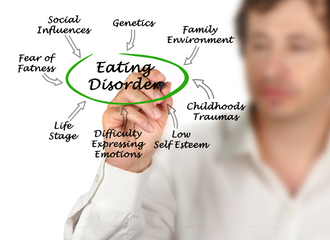As a teacher, it’s important to learn how to recognize the signs and symptoms of eating disorders and understand your role in preventing them. In this post we review the common types of eating disorders, why students are at risk, and finally what teachers can do to support their students.
 It is estimated that as many as 30 million individuals in the United States will develop an eating disorder at some point during their lifetime. Affecting both physical and mental health, eating disorders are complex psychiatric disorders with biological, genetic, psychological, psychosocial, cultural, and developmental roots.
It is estimated that as many as 30 million individuals in the United States will develop an eating disorder at some point during their lifetime. Affecting both physical and mental health, eating disorders are complex psychiatric disorders with biological, genetic, psychological, psychosocial, cultural, and developmental roots.
What are the primary types of eating disorders?
The most common eating disorders are binge-eating disorder, bulimia, anorexia, and other specified feeding or eating disorder (OSFED).
People with Binge-eating disorder engage in binge eating episodes. They eat large amounts of food in a discrete period of time, often feeling out of control and past feeling full. Those struggling with binge-eating disorder often experience a great deal of shame for binge eating and unlike bulimia, they do not compensate for the food intake.
Individuals with Bulimia Nervosa engage in cycles of binge eating and purging behaviors to compensate for binge eating episodes. The purging associated with bulimia may take many forms including self-induced vomiting, excessive use of laxatives or diuretics, or compulsive exercising.
Those who struggle with Anorexia Nervosa or Atypical Anorexia Nervosa (technically listed under the OSFED diagnosis) purposefully restrict their intake, which leads to significant weight loss and/or a significantly low body weight in the context of age, developmental trajectory, and physical health. These individuals have an intense fear of gaining weight and high levels of body dissatisfaction regardless of weight, shape, or body size. Those with AN binge/purge type also engage in binge eating episodes and/or purging.
Finally, Other Specified Feeding or Eating Disorder (OSFED) is a diagnosis given to those who do not meet the strict diagnostic criteria for AN, BN, or BED, but report behaviors and symptoms severe enough to cause impairment across various domains.
Why are students at risk to develop eating disorders?
Making the transition to middle school, high school or college can be challenging for many students, particularly for those with an eating disorder. Transitions take us through a range of emotions, and often include complex and difficult paths we must figure out how to navigate. As a result, students may activate – or even relapse – the onset of disordered eating.
Students with Elevated Risk:
- Athletes in weight focused sports (e.g., ballet, wrestling, gymnastics)
- Students with a parent or sibling with an eating disorder
- History of being bullied or discriminated against for appearance or weight
- Perfectionistic or “Type A” personalities
- Impulsive behaviors
- Poor body image
- Dieters (or history of dieting)
- Co-occurring diagnoses (e.g., ADHD, OCD, mood disorders, autism)
- LGBTQ+ students
- Students in food insecure households
- Students with a history of trauma, substance use, and/or self-harm
Signs You Should Act or Intervene:
- Ongoing restricting, bingeing and/or purging
- Intense fear of weight gain and/or preoccupation with weight, size and shape
- Excessive guilt, anxiety or fear associated with food or exercise
- Medical complications, even minor ones
- Weight fluctuation – significant over short period of time, relative to everyone’s trends
- Depressive episodes and/or anxiety
- Grade fluctuations and/or steadily dropping grades
- Social withdrawal from friends and family
10 Ways Professionals Can Make a Difference in Schools
Teachers, coaches, school counselors, and administrators play an important role in a student’s continued recovery. Below are a few ways to promote eating disorder prevention and awareness among your students:
- Develop health class curricula about size and shape diversity, eating disorders, disordered eating patterns, body image concerns, as well as the harmful effects of diet culture, weight stigma and weight discrimination.
- Plan activities for Eating Disorders Awareness Week — in February of each year.
- Help students understand advertising ploys that promote body image dissatisfaction and join in efforts against the cultural idealization of thinness.
- Establish programs that help students recognize and develop “inner” qualities and values (honesty, kindness, creativity, etc.).
- Sponsor events for students and parents to hear testimonies of fellow classmates who have chosen the path to recovery.
- Teach students and start peer support groups to help students talk to those whom they suspect might have a body image concern or an eating disorder.
- Don’t allow school activities which promote weight loss or emphasize appearance. Assess your own weight biases here.
- Evaluate your own relationship with food and how well you respect your body by taking our Healthy Relationship With Food Quiz.
- Request copies of the quiz and distribute to students in health classes. Allow opportunities for discussion.
- Refer students you are concerned about to The Renfrew Center for a comprehensive assessment.
Conclusion
During a transitional period of life, the risk of developing harmful behaviors can be exacerbated. Knowing the risk factors, signs and symptoms and providing early intervention can give students the opportunity to fully recover and lead a successful life free from the restraints of an eating disorder.
If you’re unsure whether a student is struggling with an eating disorder, The Renfrew Center can help by providing free consultation with one of our Clinical Assessors, or to assist your student in scheduling an eating disorder assessment. Renfrew offers free screening tools for students, as well as support and information for loved ones, on how to help. Recovery from an eating disorder is possible and help is available.



